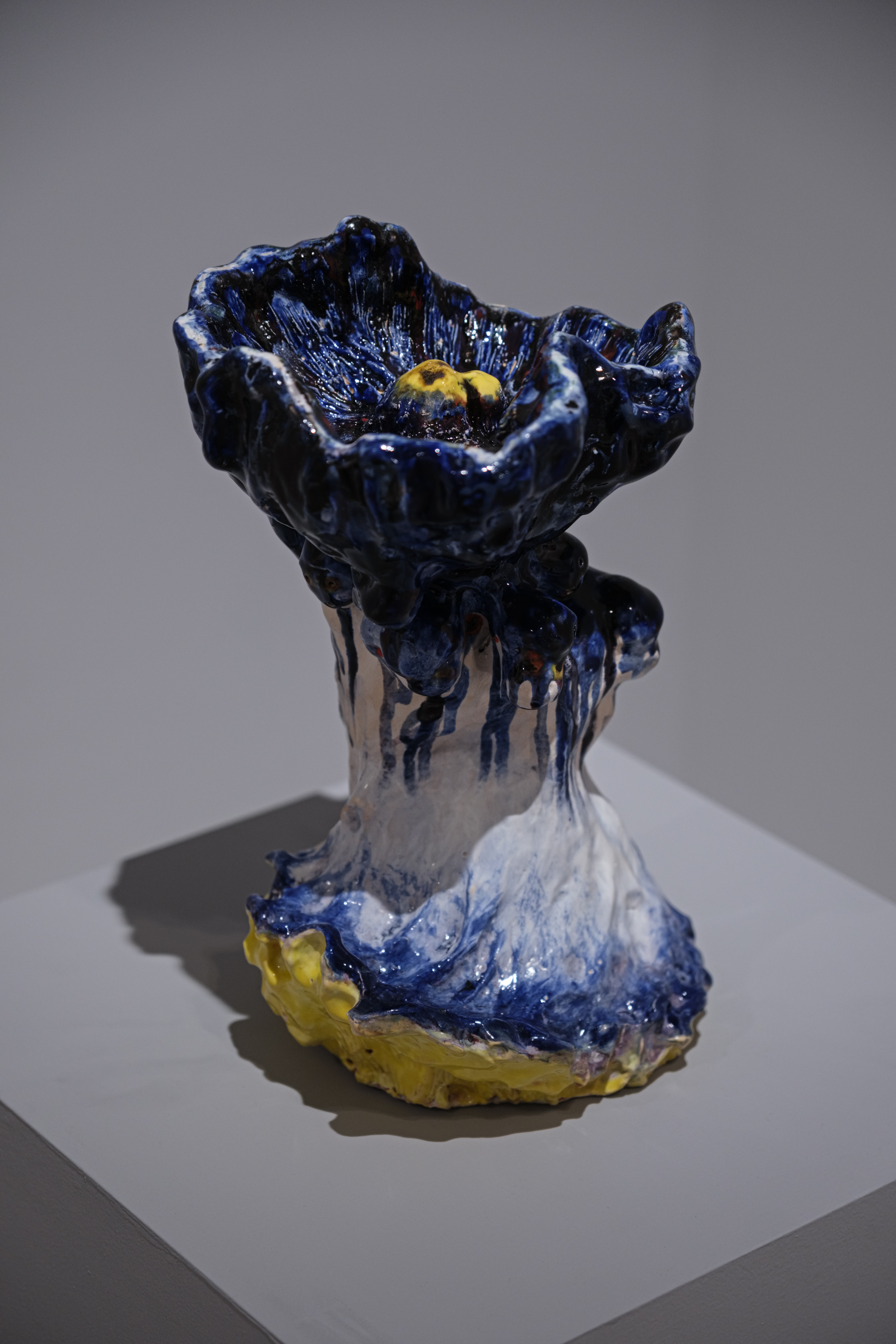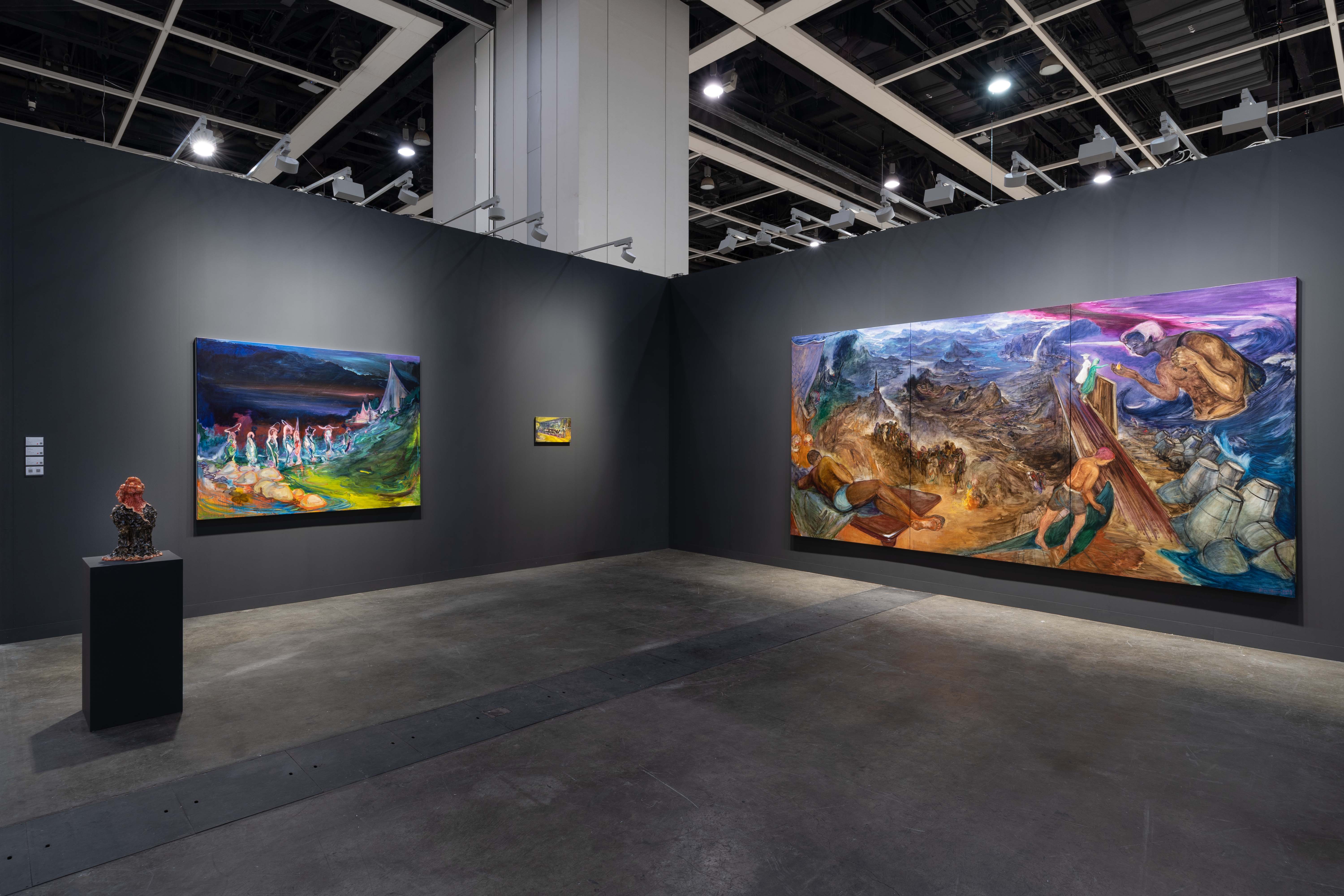Rao Fu: Transcending Time and Space
By Camilla Alvarez-Chow

Portrait of RAO FU. Courtesy the artist.
In our globalized and hyper-connected world of immediate, virtual interactions and cheap travel we are arguably better placed than ever to understand the universality of human experience. One artist who attempts to reconcile our differences through his work—especially those between Asia and the rest of the world—is the Beijing-born Rao Fu. His visceral brushwork and use of color is inspired by the 19th-century master Edvard Munch (1863–1944), as well as contemporaries including the Scottish painter Peter Doig and the German artist Daniel Richter. Yet despite these European influences, Fu’s cultural heritage is not so easily disguised. This is evident in his vast landscapes, many of which allude to classical Chinese ink paintings. His practice is manifested through the integration of various dichotomies—the pleasure and the pain of life—as a way of getting closer to the reality of things. ArtAsiaPacific’s Camilla Alvarez-Chow sat down with Fu to discuss building cultural bridges, his extensive training, and the value of therapy.
This year at Art Basel Hong Kong (ABHK) you exhibited your work at the Mind Set Art Center’s (MSAC) booth as part of their presentation titled “Voyage.” How do you think about your paintings in relation to this word? And what kind of journey or voyage do your paintings take viewers on?
For me, “voyage” is a means of discovery. It is about embarking on a new, unknown journey. When it comes to painting, I think it should be about facing the unknown and experiencing the process of adventure. My painting is like a “voyage” that starts and ends at an unknown time. What I need to do is to continue exploring in the face of difficulty. Having lived for over 20 years in both the Asia and Europe, I have always searched for the familiar and the unfamiliar. These things have directly influenced my artistic practice. Viewers are seeing my journey through one artwork after another, getting a feel for my life experiences across dual cultures and my continual questioning of life.

RAO FU, Girl and Red Leopard, 2024, oil on canvas, 160 × 195 cm. Courtesy Mind Set Art Center.
How exactly have you blended, or drawn upon, both Western and Asian painting traditions in your work? And what in particular attracts you to these two styles of art-making?
I feel that my painting exists in the midst of a collision between two distinct cultural currents. If it’s described as a fusion, I think it’s more a question of it being harmonized after a period of turmoil followed by calm. I have been living in Dresden, in Germany, a city known for its classical art, for 23 years. Here, I absorb the impact of contemporary art while studying the techniques of traditional German Classicism. In the early years, I deliberately tried to soften the stark differences between Eastern and Western painting techniques and cultural traditions, constantly adjusting the “formula” in my paintings. Now, however, I have completely unleashed myself in the world of color. Each stroke is guided by my heart, making it impossible for me to determine which cultural soil I emerged from. I simply immerse myself in the world of my painting and revel in the surprises they bring me. As an Asian artist practicing cross-cultural art in Europe, I have always believed that the values, conflicts, and divergence in cultures can be communicated, healed, and resolved through art. I hold this belief and am drawn to using my paintings to reflect on global issues.
The largest of your works at ABHK was Paradise Lost (2024). Could you tell me more about the process of painting on such a large scale and what this work in particular is about? Does the title refer to the epic poem by English poet John Milton, Paradise Lost (1667)?
I exhibited a new three-meter-wide work titled Paradise Lost and worked on another that was over four meters long, which is for another upcoming project. If a work exceeds three meters it needs to be completed in several parts before being assembled. Creating large-scale work is a joyful and liberating process. I can paint as freely as if I were dancing on the canvas, before letting it lead me to completion. The current challenge is limited by the capacity of my studio; if it were any larger, I would have to dismantle it to get it out [of the studio].
The work for ABHK is partly inspired by [Milton’s] Paradise Lost. I won’t recount the allegories he poured into his work, but what moves me is his hope that literary works can awaken the public, which is similar to how artists use their art to pose questions. In my own work I arranged, for the first time, a continuous scene much like a long shot (as opposed to a flat perspective) featuring various characters, monkeys, and monstrous figures. When all the elements are arranged into one image it becomes like a horizontal stream of time and space, with elements of temptation, desire, separation, sacrifice, and doubt. Human nature is unmasked and stands before us, prompting deep reflection.

RAO FU, Paradise Lost, 2024, acrylic on canvas, 160 × 300 cm. Courtesy Mind Set Art Center.
Your mixed-media works on paper, including Girl and Leopard and Hunter (both 2023), seem to have been taken from the pages of a sketchbook. Is this planning phase for the larger oil paintings on canvas integral to your practice?
The works on paper were made around the same time as the oil paintings and were a way of exploring the same themes through a different medium. I don’t usually sketch first because if I follow a pre-planned drawing I would feel restricted and wouldn’t know where to start. I start by not knowing what will happen, and this relaxation allows me to enter the zone. The process is like an adventure. I don’t even know if I will be able to finish, but it is precisely this exploration (a process in which I experience profound joy) that makes me want to continue to probe further.
%20on%20paper_Image_%2034%20x%2026%20cm,%20Sheet_%2041%20x%2033%20cm.jpg)
RAO FU, Hunter, 2023, water color, gouache, fluorescent pigment, and ink on paper, 41 × 33 cm. Courtesy Mind Set Art Center.
You also make sculptures. Is the way that you approach three-dimensional objects different from your work on canvas?
Using clay is like a childhood memory. We’ve all have had some experience of interacting with nature to varying degrees. I feel a strong sense of “reality” when creating in the three-dimensional space. The visual and tactile experiences are completely different from painting. While preparing for my solo exhibition “Night Feast” at ABHK 2023, for the first time I decided to incorporate spatial elements. Initially, I was uncertain because I had never tried to display my paintings and sculptures together. But the results were a success. In my paintings, elements that were difficult to understand changed when they transformed into three dimensions. I’m glad I persisted, as sculpture has enriched the language of my paintings.

RAO FU, Night Time Stories, 2023, cermaics, 35 × 19 × 21 cm. Courtesy Mind Set Art Center.
You took an art therapy course between 2010 and 2012. What were your motivations behind this, and what did you learn from the course that might have influenced your practice?
It gave me a lot of inspiration for painting and helped me understand that “expression” is a special ability. Even when facing a completely unfamiliar person, despite any language differences, I can still fully convey my emotions, feelings, troubles, or even my deepest secrets, through the medium of painting. I feel fortunate to have learned this skill of communicating with viewers because it has made my paintings more profound and it has allowed me to view my creations from a different perspective.
Your training has been very extensive. You spent around eight years training at Dresden’s Academy of Fine Arts and studied for your master’s under [German painter] Ralf Kerbach. What made you decide to study in Germany?
Initially, coming to Dresden was by chance. Later it became inevitable. I say this because at first I wanted to go to France. My mother visited France in the 1980s and worked in the chemical industry. She even lived in Paris for a while. I have early recollections of Paris at home. France also played a very important role in the transition from classical to modern art in the West, and I was eager to experience it firsthand. However, many things are subject to change, and I ended up getting a visa to Germany. As if by fate, I came to this city of painting, where I felt the energy of the classical masters. It was because of them that I wanted to become a painter.
How do you see as your role in society as a professional artist? What motivates you to continue making art?
I don’t feel like I have much experience as a professional artist, so I’ll just speak simply about myself. I consider myself a tiny individual in the universe, who became an artist by a chance trajectory. What I can do is sincerely record the traces that pass through my inner world. The everyday aspects of life are constantly evolving, continually disappearing—from tangible to intangible, from flowing to static. This makes me introspective. In life, in nature, in the environment, in society, even in dreams and fantasies, there is a certain repetitive cycle of thinking and decision-making that is our fate. But as an artist, I have a responsibility to look at things from a broader perspective, to ask questions, and to contribute my modest efforts to our shared present. I think I am using my roots across two cultures and my personal life experiences to repeatedly probe and question the world around me. Wherever I am, I hope my works can become true “world art,” devoid of these concepts or notions of East and West. The stories in the paintings are simply about the natural relationship between humans, devoid not only of gender, nationality, and identity, but also of time and space—the simplest relationships between people. I hope my work allows viewers to see a presentation that transcends everything. This is also my goal and my motivation for making art.

Installation view of "Night Feast" at Art Basel Hong Kong 2023. Courtesy Mind Set Art Center.
Camilla Alvarez-Chow is an editorial assistant at ArtAsiaPacific.







